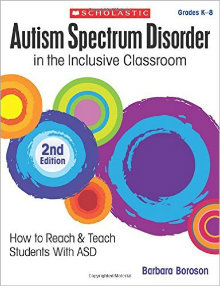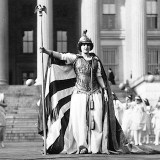How to Reach & Teach Students with Autism
Autism Spectrum Disorder in the Inclusive Classroom: How to Reach & Teach Students with ASD, 2nd ed.
By Barbara Boroson
(Scholastic Inc., 2016 – Learn more)

Autism Spectrum Disorder in the Inclusive Classroom: How to Reach and Teach Students with ASD, begins with the statement, “If you don’t have a student on the autism spectrum in your class today, you will soon.” In my personal experience, if you do not have a student on the autism spectrum in your class today, you will be fortunate to work alongside a student diagnosed with autism soon.

For the inclusive classroom and beyond
This book is divided into 11 chapters covering information useful for classroom teachers and staff working with students on the autism spectrum. It can also be a valuable resource for designing classroom applications to meet the needs of all students. Nested within each of these chapters are highlighted sections with catchy titles and more personalized commentaries, which add insight into each chapter’s content.
Barbara Boroson does a great job explaining the educational process and defining terms associated with autism in education. This book describes characteristics “typically” related to individuals with autism in the social, emotional and sensory areas, while reminding the reader “like stars in the sky, each of these students possesses unique characteristics.”
The chapters cover social struggles our students face, communication challenges, understanding their “boiling points,” the effectiveness of collaboration, classroom strategies, positive behavior management techniques, and other useful tools for educators working with students on the autism spectrum.
There are many highlights throughout this book from the first page titled Ten Things You Can Do Before Day One to the final page, which focuses on Facts and Tips for Special Area Teachers. The chapter emphasizing the family and student as the experts on the team is an indispensable part of this book.
Behavior as communication
Another important point is the idea of understanding behavior as communication and explaining the process of discovering the function behind a behavior. This chapter can be an eye opener for someone without any up-to-date behavior management training. This book has many useful nooks and crannies that could be referred to throughout a teaching career and passed on or modeled for other individuals working in the educational realm.
As an educator who has worked with students on the autism spectrum in a classroom full of diverse learners, I found this book worthwhile because of its meaningful stories, strategies and aha moments. I was able to relate and reminisce on the exciting times that are created in a classroom through the collaborative efforts of students, staff, parents and specialists.
This book would be very useful for all regular education teachers and educators beginning their career in special education and a great resource for the experienced educator to refer to periodically when we forget to use the tools we have developed through our years of experience.
A cohesive classroom team
Overall this book can be used as a guide for creating a cohesive classroom community with an electrified learning environment by recognizing our students’ strengths and unique characteristics and using these traits to strengthen our learning environment. The broad compilation included in this book offers straightforward and useful strategies to make your classroom team more successful.
Carrielynn O’Reilly is a doctoral student in Special Education with a concentration in Deaf Education and a Graduate Assistant with the Tennessee Behavior Supports Project at the University of Tennessee. She has over 18 years of special education related experience, including wilderness therapeutic education, and eight years as a classroom teacher with specialization in post-secondary transitional support and related services. Her primary areas of research interest include positive behavioral supports, Autism, communication, transition and community based experiences for students with more severe and multiple disabilities.
Read another MiddleWeb review of
Autism Spectrum Disorder in the Inclusive Classroom

































